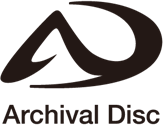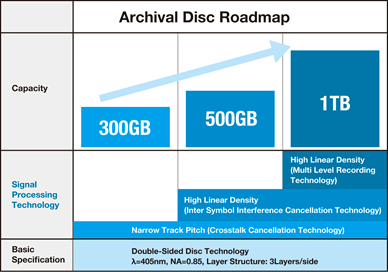Photo Corners headlinesarchivemikepasini.com
![]()
A S C R A P B O O K O F S O L U T I O N S F O R T H E P H O T O G R A P H E R
![]()
Enhancing the enjoyment of taking pictures with news that matters, features that entertain and images that delight. Published frequently.
Sony, Panasonic Formulate Next-Generation 'Archival Disc'




10 March 2014
Sony and Panasonic announced the formulation of an "Archival Disc," a next generation optical disc format designed for professional use first announced last year. Today's announcement included a roadmap of storage capacities and signal processing technology as well as key specifications and a new logo.

The companies "aim to launch" systems with a capacity of 300-GB per disc next summer before expanding to 500-GB and 1-TB capacities, which will each require different signal processing technologies.

Road Map. Signal processing technology is key.
Among the key specifications, the disc structure will be double-sided with three layers/side) using a land and groove format. Data bit length will be 79.5 nanometers using Reed-Solomon code for error correction.
Disc size (type) 300 GB (write-once) Optical parameter Wavelength λ=405 nm (nanometers), Numerical Aperture NA=0.85 Disc structure Double-sided Disc (3 layers/side), Land and Groove Format Track pitch 0.225μm (micrometers) Data bit length 79.5nm (nanometers) Error correction method Reed-Solomon Code See the news release below for more details.
'Archival Disc' Standard Formulated For Professional-Use Next-Generation Optical Discs
TOKYO, Japan -- Sony Corp. and Panasonic Corp. have announced that they have formulated "Archival Disc," a new standard for professional-use, next-generation optical discs, with the objective of expanding the market for long-term digital data storage.
The basic agreement to jointly develop a standard for professional-use next generation optical discs was originally announced on July 29, 2013.
Optical discs have excellent properties to protect themselves against the environment, such as dust-resistance and water-resistance and can also withstand changes in temperature and humidity when stored. They also allow inter-generational compatibility between different formats, ensuring that data can continue to be read even as formats evolve. This makes them robust media for long-term storage of content.
Recognizing that optical discs will need to accommodate much larger volumes of storage going forward, particularly given the anticipated future growth in the archive market, Sony and Panasonic have been engaged in the joint development of a standard for professional-use next-generation optical discs.
These efforts resulted in the formulation of "Archival Disc," a new professional-use next-generation optical disc standard, for which the technology roadmap, logo and specifications are outlined below.
Roadmap
Both Sony and Panasonic aim to launch systems with a recording capacity of 300-GB per disc from summer 2015, onwards. In addition, both companies plan to leverage their respective technologies to further expand the recording capacity per disc to 500-GB and 1 TB.

Road Map. Signal processing technology is key.
Logo
The following logo has been designed to represent the "Archival Disc" professional-use next-generation optical disc standard.

In recent times, demand for archival capabilities has increased significantly in the film industry, as well as in cloud data centers that handle big data, where advances in network services have caused data volumes to soar.
Both Sony and Panasonic have successful experience working on the development of Blu-ray Disc technology. The two companies plan to actively promote this next-generation high-capacity optical disc standard in the professional field in order to offer an effective solution for protecting valuable data into the future.
Key Archival Disc specifications
Disc size (type) 300 GB (write-once) Optical parameter Wavelength λ=405 nm (nanometers), Numerical Aperture NA=0.85 Disc structure Double-sided Disc (3 layers/side), Land and Groove Format Track pitch 0.225μm (micrometers) Data bit length 79.5nm (nanometers) Error correction method Reed-Solomon Code Crosstalk cancellation technology and high-order Partial Response Maximum Likelihood signal processing technology have been employed to achieve both larger capacity and higher playback signal quality.
Crosstalk cancellation technology electrically removes crosstalk from the adjacent tracks that increase as the track pitch becomes narrower, to achieve high-quality playback performance.
PRML is a signal processing technology that improves reproduction performance by allowing inter-symbol interference.